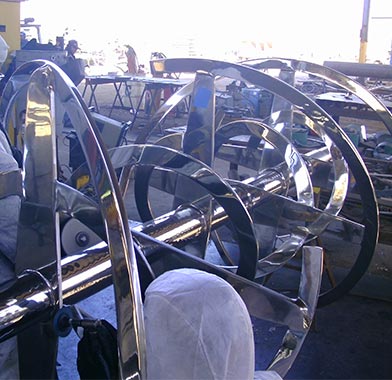Maintenance is essential for ensuring hours of trouble-free usage, just as it is for a car or other piece of machinery. Blenders are no exception, as they are frequently used for extended periods. Blending precision might suffer if regular maintenance is not performed. As a consequence, frequent maintenance may guarantee that the expense of expensive materials and additives is kept under control. To ensure proper operation, industrial blenders should be calibrated. It is recommended that blenders be inspected at least once a year. To ensure mixing precision, preventive maintenance should be performed regularly. Besides performing routine maintenance, you should review the exterior surfaces of your mixer for dirt and grime. The cab should be cleaned and checked for cracks and defects—Oil the gear housing and sliding bowl height adjustor at least twice a year. The CV, or coefficient of variation, should be checked to ensure it’s within the correct range.
Cleaning the exterior surfaces of a mixer
To extend the life of your stand mixer, cleaning the exterior surfaces involves carefully wiping away residue and food particles from the mixer’s various areas. Before cleaning the machine, turn it off and remove the bowl and attachments. Then rinse the entire machine in hot water to remove any food particles or residue. Finally, dry all parts before reassembling them.
Depending on the type of products you are mixing, you can vary the frequency of exterior surface cleaning. Check the manual if you’re unsure how often to clean your industrial blenders. Check the impeller for excessive wear and corrosion. Check the shafts for cracks and set screws for proper fit. While cleaning, it is a good idea to examine the mixing tank’s entire interior and exterior surfaces to ensure that there are no loose parts that could damage the machinery.
Inspecting the cab
There are many factors to look for when inspecting the cab of your mixer. Checking the axles and the carrying weights of the truck is vital. Besides, you should also check the cab for rust and overall wear and tear.
Greasing the paddle shaft seals
An excellent way to extend the life of your mixer’s paddle shaft is to grease the seals. First, grease the seals to keep them from seizing. Then, you can remove the paddle shaft by unscrewing the bearing and sealing the housing, and you’ll be left with a sealed shaft and an easier time replacing the paddle. In addition, you’ll minimize downtime, labor costs, and equipment damage.
Greasing the paddle shaft seals on the mixer’s paddles is a must. It will prevent excessive wear on the shaft and protect the paddle-shaft bearings from mortar contamination. If the seals aren’t greased, it will wear the shaft grooves and allow material to get past them, causing bearing failure. Lubricating the paddle shaft seals is a simple, daily maintenance task. Aim for once every four to five hours, and you’ll be able to maximize the life of your equipment. In addition, you can push out the grease at the end of the day if needed.




